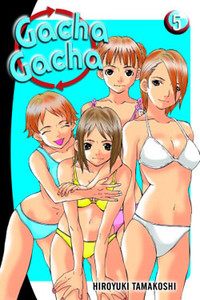Review
by Carl Kimlinger,Gacha Gacha
G.novel 4-5
| Synopsis: |  |
||
Kouhei has managed to survive dealing with Kurara's multiple personalities and even cyber-diving in Kurara's mind, but he's up against his toughest opponents yet when four new personalities rear their ugly (okay, oversexed) heads. The Original Four are, get this, the original four. Personalities that is; the highly advanced AI that all of the other women downloaded into Kurara's brain by the Gacha Gacha program were derived from. They're all beautiful, but does Kouhei really need to date them all? And are he and Kurara ever going to deal with their burgeoning feelings for each other? |
|||
| Review: | |||
In a market inundated with sound-alike stories and shopworn premises, there are a few titles that distinguish themselves with little more than slight twist and some sharp writing. Gacha Gacha isn't one of them. Gacha Gacha's premise sounds like a desperate pitch by a sleazy second-rate movie-pusher. "So there's this schlub you see. He's in love with his childhood friend, but she don't pay him much mind. And then he finds out that she's got multiple personalities. Not just one, you see, but a whole bunch! And they all act different. You got the shy one, the slutty one, the violent one. And they all want a piece of the schlub. And the reason for it all is some crazy virtual reality thing. You know, to throw in some sci-fi spice. So you got this big harem going, but the thing is it's all one girl! See? It'll be fantastic." Sorry mister sleazy second-rate movie-pusher, but it just ain't. Volumes four and five cover the conclusion of the first Gacha Gacha series, usually a time for climaxing emotions, peaking tensions, and all that good stuff that comes before a story concludes. You'll find none of that here. Instead, this crucial stretch of narrative is occupied with introducing yet another four personalities. That's right, instead of a climax, we're treated to more patented harem-comedy hijinx, in all their boob-squeezing, crotch-gazing, panty-flashing glory. Hiroyuki Tamakoshi pulls out all of the creative stops in fashioning his twisty little story-line, as Kouhei meets Ayame, one of the Original 4, goes on a date with her, wins her over and is almost seduced, and then meets Kiriko, one of the Original 4, goes on a date with her, wins her over and is almost seduced. Manage to follow that? The time spent with Ayame is entirely wasted on such romantic comedy staples as the amusement park and ninjutsu body-double bathroom seduction. OK, the last isn't exactly a staple, but that doesn't make it any more tasteful or interesting. The dynamic between Kiriko, Kurara and Kouhei lends the Kiriko material the merest spark of interest, just enough to carry it over into the story's so-called climax. While Tamakoshi wisely spends more time on Kiriko than the others, it has the unfortunate side-effect of squeezing the last half of the Original 4 into the last half of the final volume. To say that they end up with all the personality of lawn flamingoes is to do those perky pink decorations a serious disservice. Cramming the entire climax into half a volume also deals a death blow to any possible tension; the story ends before the crisis even really registers. It's sloppy, lazy and—worst of all—random. However, fans of the series to this point will be pleased to know that the story does reach a definite conclusion, and even the sequel-ready coda is cute and amusing rather than grating or exploitative. Other highlights include some mildly amusing character moments (including one of the most unromantic confessions of love ever), and enough fan-service to give a monk an aneurysm. If you're wondering what you're getting art-wise from Gacha Gacha, the covers are as honest as it gets. Tamakoshi's art is focused almost solely on the physiques of his female characters, and the care shows. Female characters get the most detail, with frequent clothing changes, striking poses and shots from varied angles (although low angles are preferred—a man could die trying to count all the panty-shots in these two volumes). Luckily Tamakoshi's women aren't over-endowed, melon-breasted bimboes or jailbait waifs, but rather are solid, realistically-proportioned, and believably attractive. If the girl's faces seem interchangeable, it's excusable. They are all the same person after all. Male character(s), on the other hand, fare rather poorly, and backgrounds, while sufficiently detailed and utilized, are often dumped in favor of a panel full of feminine flesh. But hell, with a face full of boobs and butt, who needs backgrounds, right? Del Rey does their usual fine job with this release. Handsome covers, solid binding and printing, untouched sound effects with small, unobtrusive translations, informative translator's notes and an untranslated next-volume preview all grace each book. Gacha Gacha isn't going to change any lives, but if you're on the prowl for a short, sweet harem comedy with a sci-fi twist and lots of fan-service... well, read Chobits, not Gacha Gacha. This is one story where every ounce of energy expended on drawing female figures was apparently drained directly from the story, leaving it stumbling about like the anemic victim of some monstrous narrative vampire. But if all you're looking for is a big old eyeful of (admittedly excellent) fan-service, knock yourself out. |
|
The views and opinions expressed in this article are solely those of the author(s) and do not necessarily represent the views of Anime News Network, its employees, owners, or sponsors.
|
| Grade: | |||
Overall : C-
Story : C-
Art : B+
+ Story actually concludes, oodles of fan-service. |
|||
| discuss this in the forum (3 posts) | | |||
| Production Info: | ||
|
Full encyclopedia details about Release information about |
||